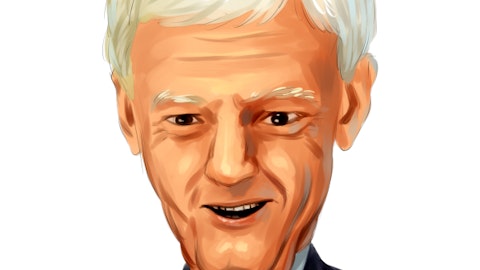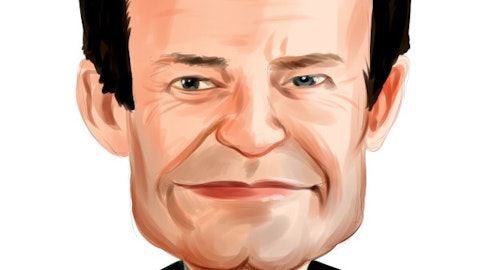Julian Francis: Yes. I’ll start and again, let Frank weigh in a little bit. So Ryan, I mean, one is labor. That’s continuing to be a challenge too is really around and still some pockets of supply chain challenge, but that’s eased considerably. I see the supply chain issues going away. I don’t see the labor going away. So I think that some of the challenges in that space. And then the last piece would probably be around uncertainty in terms of financing, how that’s going on, so projects coming out of the ground, getting bid and then sort of waiting to see how the interest rate environment evolves. So that’s where we probably see it at the high level. Ultimately, the one that’s the stickiest there is going to be the labor issue that’s going to continue to be a long-term challenge. We see the others will ease, but they’ll ease at different times.
Frank Lonegro: Hey, Ryan, other context would be, we mentioned bidding and quoting activity last quarter being up double-digits. We’ve seen that same trend in this quarter. We are seeing a shift toward smaller projects. So even though the bidding and quoting activity itself is up double-digits, the actual dollar value is up more in the low single-digit range. What that tells us is the projects are more repair and remodel, repair and replace and smaller in size, which I mean, those projects are generally not going to have the same financing side items that Julian mentioned, but larger projects and newer projects are going to have ones that probably have a little bit of financing. So I see it as two phases of the project. One would be the kind of underwriting phase, where you’ve got to get financing.
That’s going to take a little bit longer with a little bit more rigor from either the bank or the non-bank lenders. And then the labor pieces really pick up after you’ve underwritten the project and try to get it through to completion. So I think there’s a couple of different phases of that. And I do think to Julian’s good point. I mean, those things are going to resolve themselves over time. The interest rates are going to be the driver of the first one and unemployment and other things are going to be the driver of the second one.
Ryan Merkel: Helpful. Thank you.
Operator: Thank you for your question. The next question is from the line of Michael Rehaut with JPMorgan. Your line is now open.
Douglas Wardlaw: Hi, guys. Doug Wardlaw on for Mike. Just looking at the Ambition 2025 drivers. Going into 2024, if you guys could give a little bit more color and sight on how much some of these initiatives could contribute to top line growth, for example, large account focus and profit. So shift to the digital, bottom quintile branch improvement and such?
Frank Lonegro: Hey, Doug, I think it’s — most of those are going to be more margin related than anything. I mean, the bottom quintile branches in the current quarter, they did a nice job for us. They were worth about $10 million on the bottom line. They certainly grew on a year-over-year basis. They saw gross margin improvement on a year-over-year basis. They saw operating leverage on a year-over-year basis. So that initiative it was continuing to bear fruit. We would continue to expect that to bear fruit next year. From a digital perspective, I think the highlight for us in the quarter was that the residential digital sales were at 22% of total resi sales. That’s a high watermark for us. And obviously, there’s margin accretion from that.
There’s generally some basket size improvement as well. It’s a little harder to glean out, but I think that will continue to help us. Private label will continue to grow. That grew year-over-year, and obviously, it was margin accretive as well. So I think what you’re hearing us say is that these initiatives under the A25 or Ambition 2025 banner are all in flight. They’re all working. They’re all delivering benefits. The customer experience initiative is helping us drive that. The sales workforce having more boots on the ground is helping us. We’re still in the middle of the sort of pricing model software work and procedural work here. So we’re looking forward to that one into next year. So I’d say that the things that we have talked about consistently since Investor Day are the things that you’ll hear us continue to talk about in the future, and they continue to have plenty of opportunity to be helpful to the P&L.
Julian Francis: Yes. Doug, let me reference you back to some of our comments during the prepared remarks. Our Greenfields are going to continue to drive top line. We said that the Greenfields we’ve opened since we announced Ambition 2025 added around about $250 million to this year’s top line. So in terms of total top line next year, obviously, we’re going to add some more Greenfields. We’re going to have more maturity in those. So that will tick up. We said our acquisitions were performing well, and we’ve added about $400 million of acquisition-related top line growth. We would expect to see growth coming out of those, as we continue to do it, and we expect to do more acquisitions, as we go through the year. The sales initiatives that we have in place, quite honestly, they’ve been mixed, and I’ll tell you why?
In some of the residential areas, we’ve — there’s been supply constraints. And so, adding additional salespeople doesn’t yield more sales because we’ve been on allocation of product. So we would like to see an unallocated market, where the initiatives that we’re driving and the success that we’re having with these things can yield even better results. So we remain confident, as I said, that we will continue to drive top line growth next year, and we’re focused on driving margin. We haven’t yet fully implemented our pricing model that we think can drive margin. And as Frank said, we continue to grow private label. We continue to grow our national accounts business. We continue to grow our digital presence, all of which help with our margin profile.
So we feel really good about what the future is. And eventually, we’ll get a year, where everything goes our way, and we’ll make these numbers look more paltry.
Douglas Wardlaw: Got it. Thank you guys.
Operator: Thank you for your question. The next question is from the line of Trey Grooms with Stephens. Your line is now open.


